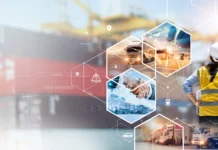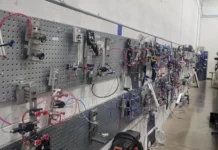by Jeffrey Dutschke, Maintenance Assistant

Google Glass is piece of wearable electronics, integrating a camera, heads-up display, touch pad, speaker and microphone. Essentially, it’s a computer weighing little more than a regular pair of safety glasses, with Wi-Fi and Bluetooth communication. The Glass wearer can communicate with the Glass using voice commands and tap gestures on the touch pad. Glass communicates to the user with a bone-conducting speaker and a heads-up display positioned above the right eye. Using the camera, the wearer can take photos and record video and send to friends and colleagues. It’s a wearable smartphone.
Facilities maintenance of the future

How will your maintenance manager complete his/her work orders in two years time? Google Glass is one highly probable answer. Google Glass provides a great opportunity to revolutionize the way technicians interact with facilities maintenance software. When fitted with a protective lens, maintenance technicians will be able to directly substitute Google Glass for their regular safety glasses. But, there is much more to this technology than some expensive Personal Protective Equipment. Imagine the following scenario:
There’s a PM due today on an air conditioning system. The technician checks what tools are needed: “Ok, Glass: Monthly PM 301, check tools list.” Glass pulls up a list of standard tools available in the toolbox. “Great, let’s go to the system.”
Arriving at the air conditioning unit, the technician scans the QR code on the unit to access all open work on this asset. “Ok, Glass: PM 301, change status from ‘assigned’ to ‘work in progress,’ and bring up list of tasks.” The list of tasks is displayed in order on the heads-up display. The technician completes the tasks one at a time as per the standard checklist. Details such as schematics, bill of materials and safe operating procedures easily will be viewed if needed.
During the PM, a major issue is spotted. Additional help is needed from a senior technician. “Ok, Glass: call Don Draper.” The technician works with the senior technician to resolve the issue using the onboard camera and phone.
“Ok, Glass: PM 301, mark all tasks as ‘complete’. Change status from ‘work in progress’ to ‘closed’.”
Consider the following ways in which Google Glass could be integrated.
See the plant from a different perspective

When an asset needs maintenance, a QR or bar code rapidly can be scanned with Glass to report its fault. The built-in camera can be used to record an image or video of the problem. The voice-to-text function can be used to add text to the request. All of this is hands-free.
The heads-up display on the Glass can be used to see and view new work orders as they arrive via CMMS. All Job Safety Analysis (JSA) quickly can be done at the site of the machine and photographs can be added. The JSA then can be forwarded to the supervisors for immediate digital sign-off.
The camera can be used to help diagnose faults. For example, a high-speed process can be videoed and played back in slow motion.
New employees can use the built-in map of the plant to help them navigate to the machine on which they will work.
The functionality can be used to digitally sign into a machine and make it inoperative while it is under maintenance.
Quickly access information and communicate
Using Google Glass, QR codes on equipment can be scanned, linking directly to the equipment’s online maintenance history.
A maintenance manual can be accessed instantly, including any videos that might assist with diagnostics or repair. An experienced technician could film a video as work was completed to use as later instruction for apprentices.

Video and voice calls can be made without leaving the machine. The Google Hangout means multiple people can meet simultaneously – for instance, maintenance, production management, technicians and operators.
Large equipment suppliers now have help desks with technical support via video link. Google Glass will allow an immediate view of the problem for their expert opinion.
Record and document
The QR or bar codes of any tools, consumables or parts used can be automatically recorded for inventory and tracking purposes.
Photographs can be taken of installation to ensure it was done properly, while at the same time uploading diagnostic data directly to the CMMS.
Completion notes can be added using voice-to-text conversion.
How far away is this future?
Google Glass technology easily will integrate with the maintenance engineer’s day-to-day maintenance activities. No pen, laptop or tablet will be required to record maintenance activities; it will be done with speech-to-text recognition. Voice commands will become commonplace in facilities maintenance when dedicated maintenance and repair applications are developed.
Google Glass will go on general release in 2014, and innovative companies will be incorporating this device into their software plans. It would be reasonable to expect that dedicated apps will be available before the beginning of 2015.
Technicians will love the freedom and flexibility provided by Google Glass. Engineers and accountants will appreciate the data it provides, and management will love the cost savings it delivers.
Jeffrey Dutschke is a product specialist and blogger at Maintenance Assistant Inc., a leading provider of innovative web-based CMMS. CMMS software is the ideal way to manage maintenance on assets such as facilities and equipment. For more information, visit www.maintenanceassistant.com.




